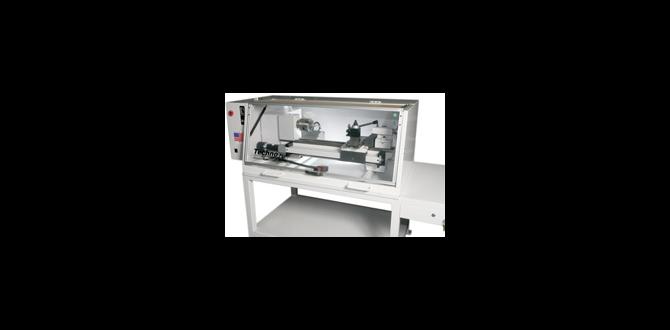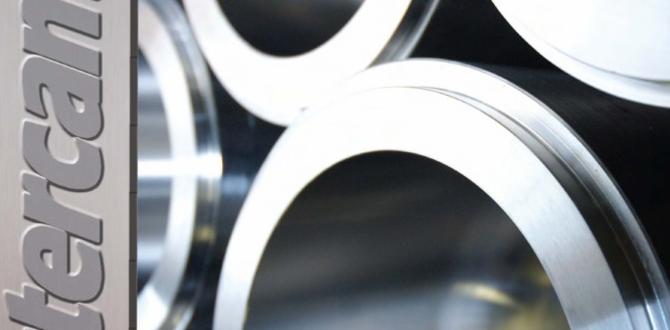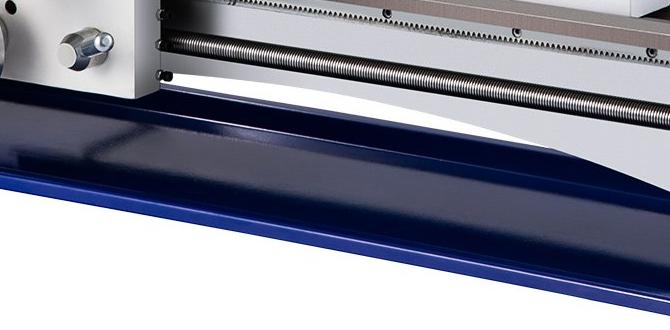Quick Summary:
A 3/16-inch carbide end mill is perfect for dry cutting various materials, especially wood, due to its hardness and heat resistance. This guide helps beginners master it, focusing on safe, effective dry cutting techniques for precise results without coolant.
Mastering the 3/16 Inch Carbide End Mill for Dry Cutting
Welcome to Lathe Hub! As a fellow machinist and tool lover, I know how it feels to stare at a new tool, wondering where to start. The 3/16-inch carbide end mill might seem small, but it’s a powerhouse, especially when you want to cut materials like wood or certain plastics without using any coolant. Many beginners find dry cutting a bit daunting because it’s different from what they might have seen in heavy industrial settings. But don’t worry! With the right approach, you can achieve clean, accurate cuts every time. We’ll walk through everything you need to know, step-by-step, so you feel confident using this versatile tool in your workshop. We’ll cover setup, best practices, and essential safety tips to make your dry cutting projects a success.
Why Choose a Carbide End Mill for Dry Cutting?
When we talk about dry cutting – meaning machining without a liquid coolant – the material of your cutting tool becomes super important. Traditional high-speed steel (HSS) cutters can overheat quickly and lose their edge when cutting dry, especially in harder materials or at higher speeds. This is where carbide shines.
Carbide (Tungsten Carbide) is an extremely hard and brittle compound. Its key advantages for dry cutting include:
Superior Hardness: Carbide is significantly harder than steel, allowing it to cut tougher materials and resist wear for longer. This means it can maintain a sharp edge even when generating heat.
High Heat Resistance: While carbide does get hot during cutting, it can withstand much higher temperatures than HSS before softening or losing its structural integrity. This is crucial for dry machining where heat can’t be dissipated by coolant.
Material Versatility: While often associated with metals, carbide end mills are excellent for dry cutting many types of wood, composites, and plastics. Many specialized carbide end mills are designed specifically for these non-metallic materials. For instance, some wood-specific ones feature specialized flute geometries for chip evacuation and a smoother finish.
Longer Tool Life: When used correctly for its intended purpose, carbide generally offers a longer tool life than HSS, especially in dry cutting scenarios.
For a 3/16-inch carbide end mill, its smaller size makes it ideal for detailed work, engraving, or making narrow slots. When you look for one, you might see specifications like “8mm shank stub length.” The 8mm shank refers to the diameter of the part that goes into your machine’s collet or chuck, and “stub length” usually means it’s shorter than a standard end mill for increased rigidity.
Understanding Your 3/16 Inch Carbide End Mill
Before you even think about spinning it up, let’s get familiar with your new tool. A 3/16-inch carbide end mill is a cutting tool with multiple cutting edges, called flutes, that remove material as it rotates. The “carbide” part means it’s made from tungsten carbide, giving it that impressive toughness. The “3/16 inch” is its cutting diameter.
Key Features to Look For:
Number of Flutes: For wood and plastics, 2-flute end mills are often preferred for dry cutting. These have fewer flutes, which means larger chip Clearances. This helps prevent chip recutting and clogging, which is a major cause of overheating and poor finish when working dry. For very fine dust or materials that produce small chips, a 4-flute might be considered, but 2-flute is generally the go-to for wood.
Coating: Some carbide end mills come with coatings (like TiN, TiCN, or DLC). While often aimed at metal cutting, certain coatings can offer additional benefits like reduced friction and improved wear resistance, which can be helpful even in dry cutting of non-metals. For wood, uncoated carbide is often sufficient and cost-effective.
Helix Angle: This refers to the angle of the cutting edges. A higher helix angle (e.g., 30-45 degrees) is often good for softer materials like wood as it slices better. A lower helix angle might be used for more aggressive material removal.
Shank Diameter: As mentioned, you might see an 8mm shank on a 3/16-inch cutter. This is common and provides good stability. It will fit in an 8mm collet or collet chuck. If your machine uses imperial sizes, you’ll need an adapter or an 8mm collet.
Length: “Stub length” means it’s shorter. This reduces vibration and deflection, making it more rigid and accurate, which is excellent for precise dry cutting.
What Materials Can You Dry Cut?
Carbide end mills, especially a 3/16-inch one, are fantastic for a range of materials when cutting dry. The key is to match the tool’s geometry and your cutting parameters to the material.
Common Dry Cutting Applications for a 3/16″ Carbide End Mill:
Wood (Hardwoods & Softwoods): This is where 3/16″ carbide end mills truly excel for hobbyists and woodworkers. They can be used for:
Routing intricate shapes.
Carving details.
Creating dados, grooves, and pockets.
Engraving text or designs.
Making signs.
Plastic: Many common plastics can be dry cut effectively. This includes:
Acrylic (PMMA) – prone to melting, so lower speeds and high feed rates are key.
Polycarbonate (Lexan) – also prone to melting.
ABS.
Delrin (Acetal).
HDPE.
Composites: Some composite materials, especially those with softer cores or certain fiberglass types, can be dry cut. However, always check manufacturer recommendations, as dust can be a health hazard.
Foam: High-density foams can be cut cleanly.
Important Note: While carbide is hard, it’s brittle. It doesn’t perform well dry in most steels, aluminum, or other hard metals. These materials typically require coolants to manage heat and lubricate the cut. For metals, you’d typically use specialized carbide end mills designed for those alloys and with appropriate coolant systems. Always refer to your machine and tool manufacturer’s guidelines for specific material compatibility.
Setting Up for Success: Your Step-by-Step Guide
Getting ready to make that first cut is crucial. A little preparation goes a long way in ensuring safety and achieving a great finish.
Step 1: Secure Your Workpiece
This is non-negotiable. Your material must be held extremely firmly. Any movement, even slight, can lead to errors, tool breakage, or accidents.
Use Clamps or a Vice: For wood, robust clamps are essential. Ensure they don’t interfere with the tool path. For smaller pieces or when precise alignment is needed, a milling vice can be ideal.
Avoid Double-Sided Tape: While sometimes used in lightweight routing, for milling machine accuracy and safety, mechanical clamping is far superior.
Step 2: Install the End Mill Correctly
Clean the Collet and Shank: Ensure both the collet and the shank of your end mill are free of dirt, oil, or debris. This ensures a tight grip.
Select the Right Collet: Use an 8mm collet for an 8mm shank end mill. If you have a different shank size, ensure you have the correct collet.
Insert the End Mill: Place the end mill into the collet.
Tighten Securely: Tighten the collet nut firmly in the milling machine’s spindle. Don’t overtighten, but ensure there’s no chance of slippage. The flutes should extend just enough to make the cut, minimizing overhang for rigidity. A general rule is to have about 1/2 to 3/4 of the cutting length engaged in the workpiece for optimal support.
Step 3: Set Your Zero Point (Work Zero)
This tells your machine where the workpiece is in relation to the cutting tool.
Use an Edge Finder or Probe: For metal, a mechanical edge finder, electronic probe, or dial indicator is used to find the edges of your workpiece.
Manual Setting (Wood): For wood at a CNC router, you’ll typically jog the tool to a corner or edge of your material and set your X, Y, and Z zeros in your control software. For manual milling, you’d use the machine’s handwheels to position the tool.
Z-Axis Zero: This is the critical height setting. Lower the tool until it just touches the top surface of your material. You can use a piece of paper – when the paper has just a little drag between the tool and the material, you’re at zero. For CNC, you can use an electronic Z-probe or simply jog down carefully.
Step 4: Input Your Cutting Parameters
This is where you tell the machine (or yourself, for manual operation) how fast to spin and how fast to move. This is crucial for dry cutting!
Spindle Speed (RPM): This is HIGHLY dependent on the material being cut and the diameter of the end mill. For 3/16″ carbide in wood:
Speeds can range from 10,000 RPM to 24,000 RPM or even higher on CNC routers.
Harder woods might need slightly slower speeds than softer woods to prevent glazing or scorching.
When in doubt, start at the higher end and listen to the tool. If it starts screaming or burning, slow down.
Feed Rate (IPM or mm/min for CNC): This is how fast the tool moves through the material.
For wood, a good starting point for a 3/16″ 2-flute end mill might be 30-60 inches per minute (IPM).
Crucially, the feed rate must be proportional to the spindle speed. If you increase RPM, you generally need to increase feed rate.
The goal is to get a “chip load” that’s just right. Chip load is the thickness of the material being removed by each cutting edge. Too small a chip load leads to rubbing and burning (like trying to shave with a dull knife). Too large a chip load can overload the tool or motor. For wood, you want to see light, wispy chips.
Depth of Cut (DOC): How much material is removed in a single pass (vertically).
For a 3/16″ tool, especially in wood, a DOC of 1/8″ to 3/16″ (or about 3-5mm) is often a good starting point.
For difficult materials or for a cleaner finish, shallower passes are better. You can always take multiple passes.
Finding the Right Parameters: This is often the trickiest part of machining. There are online calculators and charts, but experimentation is key. For wood, you are essentially “routing” with your end mill. A fantastic resource for CNC routing speeds and feeds is the Vectric forum, where users frequently discuss optimal settings for various materials and tools. Another helpful resource is the American Woodworking magazine website, which sometimes discusses router bit speeds and parameters. You can often find general guidelines for “carbide router bits for wood” which will be very close to the parameters for a 3/16″ carbide end mill on a CNC router.
Here’s a helpful table for starting points, but remember to adjust based on your specific machine, material, and the sound of the cut:
Table 1: Starting Speeds and Feeds for 3/16″ 2-Flute Carbide End Mill (Dry Cutting Wood)
| Material Type | Spindle Speed (RPM) | Feed Rate (IPM) | Depth of Cut (in / mm) | Notes |
| :———— | :—————— | :————– | :——————— | :——————————————————————- |
| Softwood | 18,000 – 24,000 | 40 – 60 | 0.125 – 0.1875 / 3 – 5 | Listen for a consistent sound; avoid burning. |
| Hardwood | 16,000 – 22,000 | 30 – 50 | 0.125 – 0.15625 / 3 – 4 | May require slower speeds and shallower cuts to prevent scorching. |
| Plywood | 18,000 – 24,000 | 40 – 60 | 0.125 – 0.1875 / 3 – 5 | Use a compression bit for a cleaner top edge if available. |
| MDF | 18,000 – 24,000 | 40 – 60 | 0.125 – 0.1875 / 3 – 5 | Very abrasive, causes tool wear faster. |
| Acrylic | 10,000 – 18,000 | 20 – 40 | 0.0625 – 0.125 / 2 – 3 | Very fast feed and shallow cut recommended to prevent melting. |
Always adjust based on sound and visual cues!
Step 5: Perform a Test Cut
If possible, always make a test cut on a scrap piece of the same material. This is your chance to:
Verify Work Zero: Ensure your starting point is correct.
Listen to the Sound: Get a feel for the cutting sound. A smooth, consistent sound is good. A high-pitched squeal or grinding indicates a problem.
Check the Chip Load: Examine the chips being produced. They should be well-formed and not powder-fine or melted.
Inspect the Surface Finish: Check for burning, rough edges, or tear-out.
Step 6: Execute Your Cut
Once you’re confident with your test cut, proceed with your actual workpiece.
Single-Pass vs. Multiple Passes: For intricate details or very hard materials, taking shallower cuts over multiple passes will yield better results and reduce stress on the tool and machine. This is especially true for pockets or slots that are deep relative to the tool diameter.
Chip Evacuation: Even though it’s dry cutting, you still need to manage chips.
Compressed Air: A blast of compressed air aimed at the cutting zone can help blow chips away, reducing recutting and localized heating.
Feed Rate/Spindle Speed Adjustment: If chips are building up and causing issues, you may need to slightly reduce your feed rate or increase your spindle speed to produce finer chips.
Best Practices for Dry Cutting with Carbide
Dry cutting is an art as much as a science. To get the best results and ensure the longevity of your carbide end mill, follow these best practices:
Prioritize Rigidity: The shorter the tool overhang (as with stub-length end mills), the better. Ensure your workpiece is clamped securely, and your machine has minimal play.
Use Appropriate Spindle Speed and Feed Rate: As emphasized before, these are critical. Think of it as efficiently slicing rather than rubbing. The goal is to remove material cleanly before the heat has a chance to build up excessively in the cutting edge.
“Chip Load” is Your Friend: Aim for a chip load that produces small, well-formed chips. This ensures you are actually cutting material, not just grinding it away.
Manage Heat: Even without coolant, you need to think about heat.
Don’t Dwell: Avoid stopping the tool in the cut. Keep it moving.
Take Appropriate Depths of Cut: Multiple shallow passes are often better than one deep pass.
Consider Air Blast: A directed stream of compressed air can be your best friend for clearing chips and providing some cooling effect.
Clean Your Machine Regularly: Dry cutting, especially wood, produces dust. This dust can accumulate, leading to calibration issues, machine wear, and potential fire hazards. Regularly clean your:
Spindle and collet.
Work area.
Dust collection system (if you have one).
Inspect Your Tool: Before and after each use, visually inspect your end mill for any signs of chipping, dulling, or wear. A damaged end mill is inefficient and can be dangerous.
Use the Right End Mill for the Job: A 3/16″ 2-flute carbide end mill is great for wood and plastics. Don’t try to use it for heavy-duty metal cutting. For metals, specific carbide grades, geometries, and lubrication are usually required. A great resource for understanding tool coatings and materials is Sandvik Coromant’s knowledge base. They are a leader in cutting tool technology and offer deep insights into material science and machining.
* Listen to Your Machine: Your ears can tell you a lot. A smooth, constant sound means you’re likely cutting well. Any chattering, screaming, or grinding suggests an issue with your speeds, feeds, depth of cut, or tool condition.
Safety First!
Machining can be rewarding, but it’s also potentially dangerous if not approached with care. Always prioritize safety.
Essential Safety Precautions:
1. **Eye Protection





